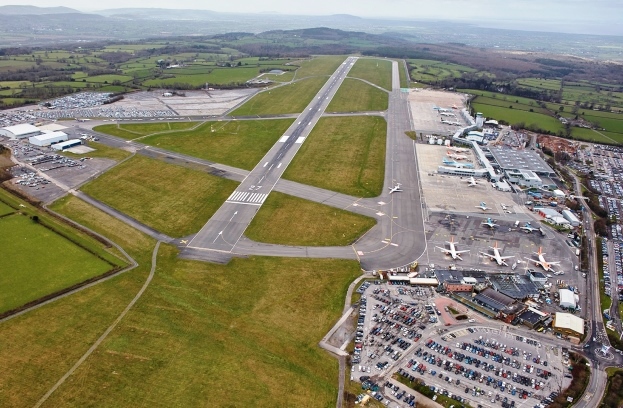UK Government decides on new runway at Heathrow

Courtesy Heathrow
The scheme will now be taken forward in the form of a draft ‘National policy statement’ (NPS) for consultation.
The government’s decision on its preferred location, which will be consulted on in the new year, underlines its commitment to keeping the UK open for business now and in the future and as a hub for tourism and trade. Today’s decision is a central part of the government’s plan to build a global Britain and an economy that works for everyone. This is just one of a series of major infrastructure investments that will create jobs and opportunities for every part of the UK.
A new runway at Heathrow will bring economic benefits to passengers and the wider economy worth up to £61 billion. Up to 77,000 additional local jobs are expected to be created over the next 14 years and the airport has committed to create 5,000 new apprenticeships over the same period.
Transport Secretary Chris Grayling said: "The step that government is taking today is truly momentous. I am proud that after years of discussion and delay this government is taking decisive action to secure the UK’s place in the global aviation market – securing jobs and business opportunities for the next decade and beyond.
"A new runway at Heathrow will improve connectivity in the UK itself and crucially boost our connections with the rest of the world, supporting exports, trade and job opportunities. This isn’t just a great deal for business, it’s a great deal for passengers who will also benefit from access to more airlines, destinations and flights.
"This is an important issue for the whole country. That is why the government’s preferred scheme will be subject to full and fair public consultation. Of course it is also hugely important for those living near the airport. That is why we have made clear that expansion will only be allowed to proceed on the basis of a world class package of compensation and mitigation worth up to £2.6 billion, including community support, insulation, and respite from noise – balancing the benefits and the impacts of expansion."
Expansion at the airport will better connect the UK to long haul destinations across the globe and to growing world markets including in Asia and South America, bringing a significant boost to trade.

Courtesy Heathrow
Heathrow already handles more freight by value than all other UK airports combined, accounting for 31% of the UK’s non-EU trade, and its expansion will create even more opportunities for UK business to get their goods to new markets.
While there are clear gains for business, passengers will also benefit from a greater choice of airlines, destinations and flight times. The Airports Commission, chaired by Sir Howard Davies, anticipated that a new runway would bring in new capacity to meet demand and allow greater levels of competition, lowering fares even after taking into account the costs of construction.
Expansion costs will be paid for by the private sector, not by the taxpayer. It will be for the Civil Aviation Authority (CAA), as the independent industry regulator, to work with Heathrow Airport Ltd and airlines operating at the airport, on the detailed design and costs to ensure the scheme remains affordable. The government expects the industry to work together to drive down costs to benefit passengers. The aim should be to deliver a plan for expansion that keeps landing charges close to current levels.
This new runway will deliver major economic and strategic benefits to the UK, but it must be delivered without hitting passengers in the pocket. The Airports Commission was clear that this is achievable as is the CAA.
A third runway will also support new connections to the UK’s regions as well as safeguarding existing domestic routes. Heathrow has proposed a further six new routes to Belfast International, Liverpool, Newquay, Humberside, Prestwick and Durham Tees Valley to be added after expansion. The eight existing routes offered today are: Edinburgh, Glasgow, Inverness, Aberdeen, Belfast City, Manchester, Newcastle and Leeds Bradford. This would provide 14 domestic routes in total, and spread benefits right across the country.
Government will also take all necessary steps including, where appropriate, ring-fencing a suitable proportion of new slots for domestic routes, to ensure enhanced connectivity within the UK.
Despite the increase in flights Heathrow Airport Ltd has made firm commitments to noise reduction. The Government will propose that a six-and-a-half hour ban on scheduled night flights will be introduced for the first time at Heathrow and will make more stringent night noise restrictions a requirement of expansion. The timing of this ban will be determined through consultation.

Courtesy Heathrow
Furthermore, the government proposes new legally binding noise targets, encouraging the use of quieter planes and a more reliable and predictable timetable of respite for those living under the final flight path. The airport has also pledged to provide over £700 million for noise insulation for residential properties.
In addition, modernising use of our air space will boost the sector and will help to further reduce noise and carbon emissions. Proposals will be brought forward to support improvements to airspace and how to manage noise, including the way in which affected communities can best be engaged and whether there is a role for a new independent aviation noise body as the Airports Commission recommended.
The Airports Commission concluded that even with the extra flights added by the airport’s expansion fewer people would be affected by noise from Heathrow by 2030 than are today.
Following the clear recommendation of the Airports Commission the government conducted more work on the environmental impact. That work is now complete and confirms that a new runway at Heathrow is deliverable within air quality limits, if necessary mitigation measures are put in place, in line with the ‘National air quality plan’, published in December 2015.
The UK has already achieved significant improvements in air quality across a range of pollutants. Emissions of nitrogen oxides in the UK fell by 41% between 2005 and 2014. Heathrow’s scheme includes plans for improved public transport links and for an ultra-low emissions zone for all airport vehicles by 2025. The government will make meeting air quality legal requirements a condition of planning approval.
A draft NPS setting out why the government believes this scheme is the right one for the UK will be published in the new year when the public will be consulted on the proposals.
In addition, up to £450 million could be available to local authorities through business rate retention. A Community Compensation Fund could make a further £750 million available to local communities. This will be determined through the planning process.
Further information
Airport expansion will be delivered through a thorough, faster planning process, under the 2008 Planning Act and 2011 Localism Act. The government will set out the airport scheme it wants, along with supporting evidence, in its NPS. Public and Members of Parliament will be consulted and there will be a vote in the House of Commons. This will be followed by a planning application by the airport to the Planning Inspector who will take a view and advise government of his decision. Final sign off will be by the Secretary of State for Transport and then construction will start.
In time a new runway will also require the redesign of the airport’s flightpaths. This will form part of a wider programme of airspace modernisation which is already needed across the country in the coming years. The government expects to consult in the new year on a range of national proposals covering noise and airspace.
Expansion at Heathrow Airport Ltd will be accompanied by a comprehensive package of mitigation measures which will be subject to consultation with the public as part of the draft NPS consultation process. The measures will also be subject to regulatory approval by the CAA.
The Department for Transport has also set up a working group with Her Majesty’s Treasury and the Department for the Environment Food and Rural Affairs on air quality. This is part of a 10 year project to accelerate improvements in air quality.
Today’s announcement follows an unprecedented UN global agreement achieved earlier this month to combat aviation emissions. Under the deal, airlines will offset their emissions with reductions from other sectors to deliver carbon neutral growth for the aviation sector from 2020. The government believes that a new runway at Heathrow can be delivered within the UK’s carbon obligations.
Meanwhile, the government wants to see the continued prosperity of the UK’s second busiest airport, and the world’s busiest single runway airport, Gatwick.
The Airports Commission led by Sir Howard Davies, was set up in September 2012. It published its final report in July 2015. In December 2015 the then Secretary of State for Transport Sir Patrick McLoughlin announced that Government accepted the case for airport expansion in the south-east and the Airports Commission’s shortlist of options for expansion.
 Paul Everitt (right), CEO of aerospace trade body ADS Group, said: “The decision to increase runway capacity at Heathrow Airport is a welcome one; it will enable the UK to remain globally competitive with a route network that ensures valuable connections to established and emerging markets.
Paul Everitt (right), CEO of aerospace trade body ADS Group, said: “The decision to increase runway capacity at Heathrow Airport is a welcome one; it will enable the UK to remain globally competitive with a route network that ensures valuable connections to established and emerging markets.
“It is now important to get on with planning and construction so that the infrastructure is provided within a reasonable timeframe.
“Mitigating the environmental impacts of increased aviation has been an overriding priority throughout the debate. The UK’s aerospace industry leads the world in developing innovative technology that makes aircraft more fuel efficient, less polluting and quieter.
“As demand for air travel increases, UK airlines are expected to invest around £60bn in new aircraft over the next 20 years. For UK aerospace companies this represents major opportunities for growth and a sustained economic return for the nation’s finances.”
A Heathrow spokesperson said: "We welcome the news that Heathrow is the Government's preferred site for a new runway and look forward to hearing the full details later from the Transport Secretary.
"Expansion of Heathrow is the only option that will connect all the UK to global growth, helping to build a stronger and fairer economy.
"We await the full details, but Heathrow stands ready to work with Government, businesses, airlines and our local communities to deliver an airport that is fair, affordable and secures the benefits of expansion for the whole of the UK."
The Airport Operators Association (AOA) acknowledges the Government’s announcement setting out its full response to the Airports Commission Final Report and will be giving a considered statement in due course. Chief Executive of the AOA, Darren Caplan said: “We have consistently said that the UK needs to compete in both established and emerging markets. This decision today is a first step in the process towards ensuring the UK has the additional capacity it needs to help the country deliver, sustainably, the connectivity it requires in the future. At this time of increased uncertainty following the Brexit vote, we need to maintain momentum, remove uncertainty and ensure the UK gets the additional capacity it so vitally needs as soon as possible to demonstrate the UK is open for business and confident about its future.
“The AOA is also clear that the UK requires excellent aviation connectivity right across the country, both vibrant point-to-point airports and world-class hub capacity. So we support all airports that wish to grow and believe in also making best use of existing capacity at all UK airports. The Government needs to refresh its Aviation Policy Framework as soon as possible to enable better surface access to airports, airspace modernisation, the lack of which is currently constraining our sector’s ability to grow, and a planning system with a presumption in favour of sustainable development.
“We also need to learn the lesson that big infrastructure projects, such as airport developments, need to be prioritised by the Government if we are to have the aviation network we need to deal with the substantially increased passenger numbers and freight volumes expected in the years ahead. The Department for Transport’s most optimistic passenger forecast scenarios from 2013 showed London and South East airports being full by 2030, and airports outside London and the South East filling up from 2040 – yet 2015’s actual passenger numbers were already almost 17 million higher than the 2013 forecast. This is an agenda which benefits not just airports around the country, but also UK plc, and its economy and connectivity more widely.”
 Martin Rolfe (right), NATS Chief Executive Officer, said: “We welcome the Government’s clear decision on the location of a new runway and its announcement of a faster planning process to deliver it.
Martin Rolfe (right), NATS Chief Executive Officer, said: “We welcome the Government’s clear decision on the location of a new runway and its announcement of a faster planning process to deliver it.
“We will be working closely with Heathrow Airport and all stakeholders to develop airspace designs that help maximise the benefits whilst maintaining safety and minimising noise and other environmental impacts.
“Having now made an important decision to secure the future runway capacity the country needs, we must get on with modernising airspace right across the UK to ensure we can meet the forecast growth in air traffic of 40% by 2030.
“We are delighted to see the Government’s support for airspace modernisation, which will be crucial to future efficiency. Without such airspace modernisation, over the coming years the travelling public will see a major rise in delays and flight cancellations.
“These decisions will signal to the world that the UK is open for business, which is more important now than ever.”
Reacting to the news, ACI EUROPE welcomed the fact that the UK government has finally clarified its position on expanding airport capacity in the UK. ACI EUROPE called for this additional capacity to be delivered swiftly, as well as for further airport capacity development and legal certainty on the future of the UK-EU aviation relationship.
 Olivier Jankovec (right), Director General ACI EUROPE commented: “This announcement brings us closer to the end of one of the longest, most publicly-consulted infrastructure planning processes, anywhere in the world. While a positive development in itself, this is just a first step requiring both swift implementation and a plan for further airport capacity development – not least because this new runway at Heathrow will not be enough to meet future demand for air transport. An island economy lives or dies by its air connectivity. If the UK Government is serious about its focus on economic growth and preserving the country’s global positioning, it needs to truly embed air connectivity and sustainable airport development in its economic strategy. This has become a common feature of some of the world’s most dynamic and forward-looking economies.
Olivier Jankovec (right), Director General ACI EUROPE commented: “This announcement brings us closer to the end of one of the longest, most publicly-consulted infrastructure planning processes, anywhere in the world. While a positive development in itself, this is just a first step requiring both swift implementation and a plan for further airport capacity development – not least because this new runway at Heathrow will not be enough to meet future demand for air transport. An island economy lives or dies by its air connectivity. If the UK Government is serious about its focus on economic growth and preserving the country’s global positioning, it needs to truly embed air connectivity and sustainable airport development in its economic strategy. This has become a common feature of some of the world’s most dynamic and forward-looking economies.
“Last but not least, today’s announcement can be no substitute for much needed legal certainty over the future of the UK-EU aviation relationship. There must be quick reassurances that as part of its Brexit strategy, the UK Government will seek to ensure that the UK and EU aviation market will remain closely integrated - with EU and UK airlines continuing to enjoy free market access.”
As recognised by the EU Aviation Strategy launched last year, the lack of sufficient airport capacity remains one of the main challenges faced by European aviation – with the situation being particularly acute in the UK. EUROCONTROL has forecast¹ that insufficient levels of airports capacity will result in 12% of demand for air transport not being accommodated by 2035 – or 1.9 million flights not taking place. The lack of airport capacity will mainly affect medium-sized and larger airports – reflecting a trend of air traffic concentration as airlines tend to focus on primary markets & higher yields. Along with Turkey², the Netherlands and Belgium, the UK is expected to face a significant shortage of airport capacity³.
Jankovec said: “Europe continues to face an airport capacity crunch over the next 20 years. This will obviously hurt aviation – with delays & flight cancellations expected to reach unprecedented levels throughout the entire network and also generating huge environmental inefficiencies. In addition, this will damage our economies with the resulting weakened air connectivity costing €97 billion in lost GDP annually and nearly two million jobs missed out on by 2035.”
Paul Drechsler CBE, CBI President, said: “The Prime Minister’s green light to expand the UK’s aviation capacity comes as an enormous relief to firms in every corner of the country.
“A new runway at Heathrow is really fantastic news, especially as the country has waited nearly 50 years for this decision. It will create the air links that will do so much to drive jobs and unlock growth across the UK, allowing even more of our innovative, ambitious and internationally focussed firms, from Bristol to Belfast, to take off and break into new markets.
“With contracts to tender for, apprentices to recruit and supply chains to build, this decision must be taken forward swiftly, giving businesses the confidence to invest. Our aviation capacity is set to run out as early as 2025, so it’s crucial we get spades in the ground as soon as possible to reap the benefits for jobs and growth, precisely when the country needs them most.
“This project should form part of a long-term framework for aviation capacity for the whole of the UK. Pressing ahead with key infrastructure projects like this will provide not only a welcome economic stimulus, but will show the world that we are well and truly open for business as we negotiate our exit from the EU.”
Paul Le Blond, Chair, Aviation Policy Group, Chartered Institute of Logistics and Transport (CILT) said: "The end to uncertainty over airports policy is welcomed by logistics and transport professionals, whichever option they supported, but there can be benefits for all parties, who can now take action to ensure that the decision is implemented in the best possible way for all.
"Logistics and transport operators, from airlines to freight companies, should use the opportunities that this decision will bring to plan long-term investments in more sustainable infrastructure, equipment and working practices, in order to create a lower carbon footprint and to meet air quality standards.
"Communities around the airport should seize the opportunities created for employment and for supplying the expanding airport, not just immediately, but over a long-term period, through education, training and entrepreneurship."














